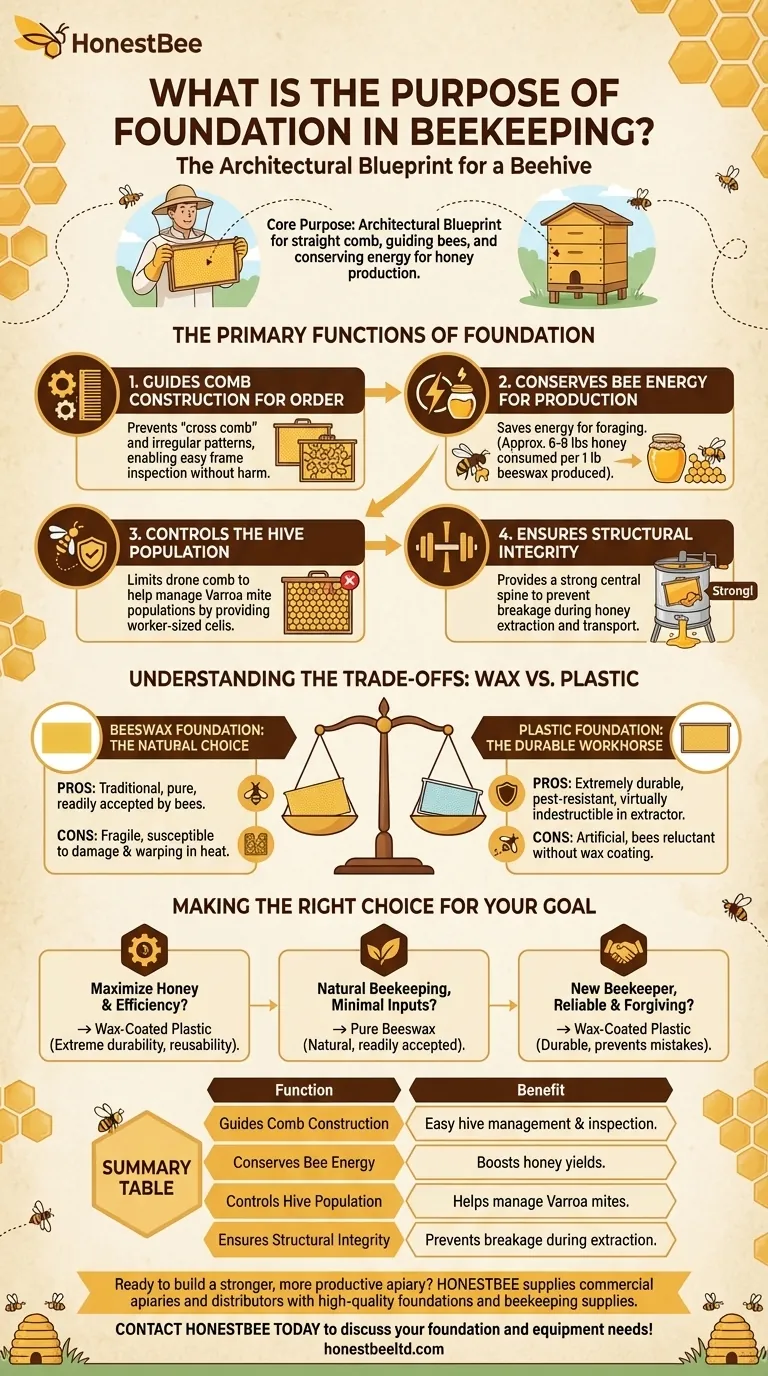At its core, foundation is the architectural blueprint for a beehive. It is a thin sheet, made of either beeswax or plastic, that is imprinted with the hexagonal pattern of honeycomb cells. Beekeepers place foundation inside frames to give bees a guide, ensuring they build straight, orderly, and structurally sound comb for raising brood and storing honey.
The surface purpose of foundation is to create straight combs for easy hive management. The deeper purpose is to strategically redirect the colony's energy from wax production toward honey production and to give the beekeeper control over the hive's structure and population.

The Primary Functions of Foundation
Foundation is considered one of the most important inventions in modern beekeeping because it fundamentally changes the dynamic between the beekeeper and the colony. It provides four key benefits.
Guiding Comb Construction for Order
Without guidance, bees will often build "cross comb"—connecting comb between frames or in irregular patterns.
This makes it impossible for a beekeeper to remove a single frame for inspection without tearing up the hive and potentially harming the bees or the queen. Foundation ensures bees build parallel to the frame, allowing for easy removal and management.
Conserving Bee Energy for Production
Bees produce wax from glands on their abdomens, a process that consumes a significant amount of energy. To produce one pound of beeswax, bees must consume roughly six to eight pounds of honey.
By providing foundation, the beekeeper gives the bees a massive head start. They can draw out the existing cells rather than building them from scratch, saving a vast amount of energy that can be redirected to foraging for nectar and producing more honey.
Controlling the Hive Population
Foundation is typically stamped with cell sizes appropriate for worker bees. Left to their own devices, bees will build a certain percentage of larger cells for raising drones (male bees).
While drones are necessary for mating, an excessive drone population contributes little to the hive's workforce and consumes resources. More importantly, the larger drone cells are the preferred breeding ground for the destructive Varroa mite. Using foundation limits drone comb, thereby helping to control Varroa populations.
Ensuring Structural Integrity
Comb filled with honey is incredibly heavy. Natural, foundationless comb can be fragile and may break under its own weight, especially during inspections or transport.
Foundation adds a strong central spine to the comb. This is particularly crucial during honey extraction, where frames are spun at high speed in a centrifuge. A strong comb remains intact and can be returned to the hive for reuse, saving the bees time and energy yet again.
Understanding the Trade-offs: Wax vs. Plastic
The choice of foundation material is a key decision for any beekeeper, with each type presenting a different set of advantages and disadvantages.
Beeswax Foundation: The Natural Choice
Made from pressed sheets of pure, recycled beeswax, this is the most traditional option. Bees readily accept it and draw it out into comb because the material is familiar to them.
However, wax foundation is more fragile than plastic. It can be susceptible to damage during high-speed extraction and can warp in extreme heat if not fully drawn out by the bees.
Plastic Foundation: The Durable Workhorse
Plastic foundation is extremely durable, resistant to pests like wax moths, and virtually indestructible in a honey extractor. This makes it highly efficient and reusable, which is why it is the standard for most large-scale commercial beekeepers.
The main drawback is that it is an artificial material. Bees can be more reluctant to build on plain plastic, so it is almost always coated in a thin layer of beeswax to encourage acceptance.
Making the Right Choice for Your Goal
Your beekeeping philosophy and objectives should guide your choice of foundation.
- If your primary focus is maximizing honey production and efficiency: Wax-coated plastic foundation is the most pragmatic choice due to its extreme durability and long-term reusability.
- If your primary focus is natural beekeeping with minimal artificial inputs: Pure beeswax foundation aligns best with this philosophy and is readily accepted by the bees.
- If you are a new beekeeper seeking a reliable and forgiving option: Wax-coated plastic foundation offers an excellent balance, providing the durability that prevents beginner mistakes while still being highly acceptable to the bees.
Ultimately, foundation is a powerful tool that enables a cooperative partnership between you and your bees for a healthier, more productive hive.
Summary Table:
| Function | Benefit |
|---|---|
| Guides Comb Construction | Ensures straight, orderly comb for easy hive management and inspection. |
| Conserves Bee Energy | Redirects energy from wax production to honey production, boosting yields. |
| Controls Hive Population | Limits drone comb to help manage Varroa mite populations. |
| Ensures Structural Integrity | Provides a strong comb spine to prevent breakage during honey extraction. |
Ready to build a stronger, more productive apiary?
HONESTBEE supplies commercial apiaries and beekeeping equipment distributors with high-quality, durable foundations and beekeeping supplies through our wholesale-focused operations. Let us help you equip your hives for maximum efficiency and honey production.
Contact HONESTBEE today to discuss your foundation and equipment needs!
Visual Guide

Related Products
- Manual Beeswax Comb Foundation Machine Wax Foundation Mill Embossing Machine
- Beeswax Foundation Sheets Beehive Foundation for Wholesale
- Food Grade Plastic bee Foundation for Bee Frames
- Professional Frame Preparation: The HONESTBEE Electric Wire Embedder
- Manual Spur Wheel Wire Embedder for Foundation
People Also Ask
- What is the use of a comb foundation mill? Boost Honey Production with Strategic Hive Control
- What is the function of a beeswax foundation machine? Boost Hive Efficiency and Honey Production
- What is the importance of soaping the rollers during milling? Prevent Wax Adhesion & Equipment Downtime
- What is a comb foundation mill? A Strategic Tool for Stronger, More Productive Hives
- What are the different uses of comb in a bee hive? A Guide to the Hive's Essential Architecture



















